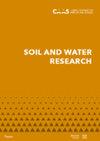Soil organic carbon fractions comparison after 40-year long-term fertilisation in a wheat-corn rotation field
IF 1.7
4区 农林科学
Q4 SOIL SCIENCE
引用次数: 0
Abstract
Several experimental methods have been developed to fractionate soil organic carbon (SOC) into functional sub-pools. However, which fractions had the potential to better reflect the SOC dynamics responding to fertilisation are still under discussion. Thus, we compared different SOC fractions (microbial biomass carbon, MBC; dissolved organic carbon, DOC; permanganate-oxidisable carbon, POXC; particle organic carbon, POC, and aggregation organic carbon fractions) and the soil respiration rate in a wheat-corn rotation field after 40 years of manure and N fertilisation in North China to search for the most sensitive SOC fractions to fertilisation. Manure increased the organic carbon (OC) contents of all the soil fractions (26.5 to 362.8%) and the POC (18.0 to 43.7%) and macro-aggregation percentages (3.0 to 4.4%), which indicated an increasing physical-protected aggregated OC fraction. N fertilisation alone slightly increased the OC contents of all the soil fractions and DOC percentage, but decreased the macro-aggregation OC percentage, which suggests the increasing possibility that the SOC is exposed to microbial communities causing a decreasing aggregation formation. However, when a high level of both the manure and N fertiliser were applied, the excessive N in the soil stimulates the soil microbial activity and decreases the SOC content comparing it to the same level of the manure fertiliser addition.小麦-玉米轮作农田长期施肥40年后土壤有机碳含量的比较
为了将土壤有机碳(SOC)分馏成不同的功能子库,研究了几种不同的实验方法。然而,哪些组分有可能更好地反映土壤有机碳动态对施肥的响应仍在讨论中。因此,我们比较了不同的有机碳组分(微生物生物量碳,MBC;溶解有机碳DOC;高锰酸可氧化碳;土壤有机碳、POC和团聚体有机碳组分)和土壤呼吸速率,以寻找对施肥最敏感的有机碳组分。有机肥增加了土壤各组分有机碳(OC)含量(26.5 ~ 362.8%)、POC含量(18.0 ~ 43.7%)和宏观团聚体百分比(3.0 ~ 4.4%),表明物理保护的团聚体OC含量增加。单施氮肥对土壤各组分的有机碳含量和DOC百分比有轻微的提高,但对宏观团聚OC百分比有一定的降低,表明有机碳暴露于微生物群落导致团聚体形成减少的可能性增大。然而,当高水平施用有机肥和氮肥时,土壤中过量的氮刺激了土壤微生物活动,与相同水平的有机肥相比,土壤有机碳含量降低。
本文章由计算机程序翻译,如有差异,请以英文原文为准。
求助全文
约1分钟内获得全文
求助全文
来源期刊

Soil and Water Research
Water resources, Soil Science, Agriculture-WATER RESOURCES
CiteScore
4.60
自引率
0.00%
发文量
26
审稿时长
>12 weeks
期刊介绍:
An international peer-reviewed journal published under the auspices of the Czech Academy of Agricultural Sciences and financed by the Ministry of Agriculture of the Czech Republic. Published since 2006.
Thematic: original papers, short communications and critical reviews from all fields of science and engineering related to soil and water and their interactions in natural and man-modified landscapes, with a particular focus on agricultural land use. The fields encompassed include, but are not limited to, the basic and applied soil science, soil hydrology, irrigation and drainage of lands, hydrology, management and revitalisation of small water streams and small water reservoirs, including fishponds, soil erosion research and control, drought and flood control, wetland restoration and protection, surface and ground water protection in therms of their quantity and quality.
 求助内容:
求助内容: 应助结果提醒方式:
应助结果提醒方式:


